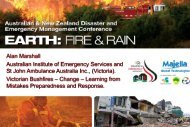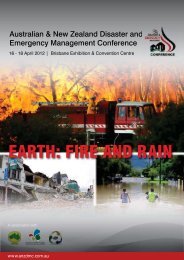Book of Abstracts 2013 - Australian and New Zealand Disaster ...
Book of Abstracts 2013 - Australian and New Zealand Disaster ...
Book of Abstracts 2013 - Australian and New Zealand Disaster ...
You also want an ePaper? Increase the reach of your titles
YUMPU automatically turns print PDFs into web optimized ePapers that Google loves.
Human Services Delivery Research Alliance which is into its fourth year <strong>of</strong> a five-year partnership between the<br />
Department <strong>and</strong> the CSIRO. Through the Alliance, the department uses the scientific research capability <strong>of</strong> the CSIRO to<br />
help identify ways to improve service delivery. The ERIC project supports the work practices <strong>of</strong> the Department’s<br />
Emergency Management team which is responsible for intelligence gathering <strong>and</strong> situation reporting during emergency<br />
events. This is achieved by a web based productivity tool that automatically gathers data from a range <strong>of</strong> sources,<br />
presents the data in a map based web site <strong>and</strong> supports a user to generate situation reports customized for different<br />
types <strong>of</strong> emergency events at specific locations. The ERIC tool integrates information from numerous sources: statistical<br />
regions from the <strong>Australian</strong> Bureau <strong>of</strong> Statistics; context data including demographics <strong>and</strong> details <strong>of</strong> the natural <strong>and</strong><br />
built environment; Departmental regional pr<strong>of</strong>ile data; ‘live’ data feeds describing the emergency event as it<br />
progresses; the historical record <strong>of</strong> previous ‘live’ data feeds; social media; <strong>and</strong> an archive <strong>of</strong> previous Situation<br />
Reports. This information can be focused for a specific region under investigation <strong>and</strong> collated semi-automatically to<br />
generate Situation Reports. They include information synthesised from available datasets <strong>and</strong> augmented by user<br />
provided content. The current status <strong>of</strong> the ERIC project <strong>and</strong> the developed tool will be presented highlighting its use<br />
by the Department in the summer <strong>of</strong> 2012/13. This will be followed by a short demonstration <strong>of</strong> the ERIC tool.<br />
A/Pr<strong>of</strong> Jacqui Ewart<br />
Program leader Media <strong>and</strong> Crime, Griffith University<br />
Co Author - Dr Hamish McLean, Griffith University<br />
Ducking for cover in the blame game: Media framing <strong>of</strong> the findings <strong>of</strong> inquiries into the<br />
2010/2011 Queensl<strong>and</strong> floods<br />
After a disaster, the media typically focus on who is to blame. However, we know relatively little about how the<br />
narrative <strong>of</strong> blame plays out in media coverage <strong>of</strong> the release <strong>of</strong> <strong>of</strong>ficial reports into disasters. This conference paper<br />
examines two <strong>Australian</strong> newspapers' coverage <strong>of</strong> the release <strong>of</strong> the Queensl<strong>and</strong> Floods Commission Interim Report<br />
<strong>and</strong> the Commission's Final Report to identify whether <strong>and</strong> how the news frame <strong>of</strong> blame was used. We found that in<br />
the absence <strong>of</strong> blame being allotted by the report, the newspapers resorted to the frame <strong>of</strong> failure' in news <strong>and</strong> feature<br />
articles, while continuing to raise questions <strong>of</strong> who was to blame in editorials <strong>and</strong> opinion pieces. We argue that<br />
situating coverage <strong>of</strong> the report within the news frame <strong>of</strong> failure <strong>and</strong> questioning who was to blame for the disaster,<br />
limited the media's ability to facilitate a discussion about the prevention <strong>of</strong> similar disasters in the future.<br />
Mr Cormac Farrell<br />
Environmental Scientist, Aurecon Australia<br />
Co Author - Mr Dan Pedersen, Environmental Scientist, Kleainfelder Ecobiological<br />
The Victorian Schools Bushfire Protection Project<br />
The February 2009 bushfires in Victoria were a tragic illustration <strong>of</strong> the vulnerability <strong>and</strong> risk <strong>Australian</strong> urban <strong>and</strong><br />
rural communities face in the event <strong>of</strong> an uncontrolled wildfire on a large scale. Several schools were destroyed or<br />
severely damaged as a result <strong>of</strong> these fires, <strong>and</strong> this recognised a need to provide on-site protection to students <strong>and</strong><br />
staff, <strong>and</strong> was identified as a key priority in post disaster liaison.<br />
Following Black Saturday, the Department <strong>of</strong> Education <strong>and</strong> Early Childhood Development (DEECD) engaged a multidisciplinary<br />
team to improve the protection <strong>of</strong> students <strong>and</strong> staff through school site building <strong>and</strong> l<strong>and</strong>scape<br />
modification works at over a portfolio <strong>of</strong> 300 schools identified as being at particular risk <strong>of</strong> bushfires.






